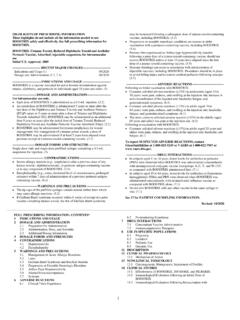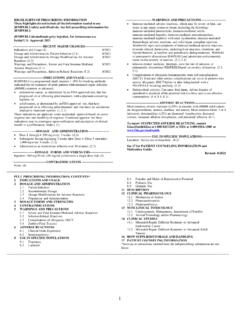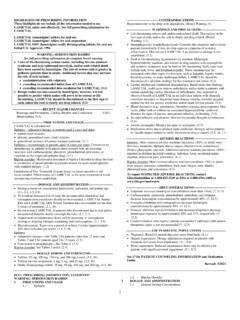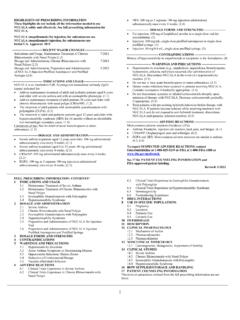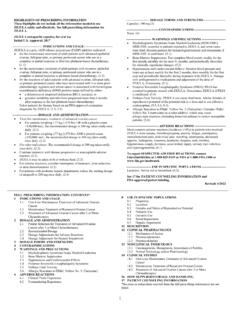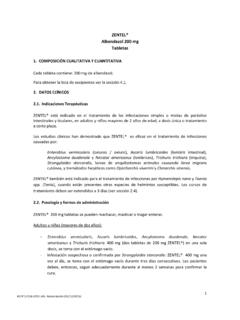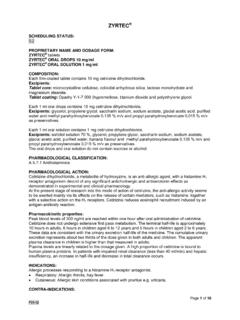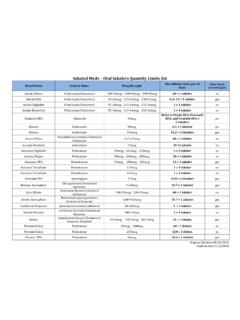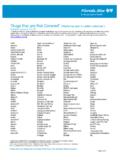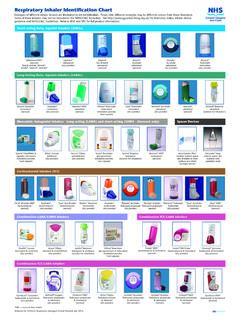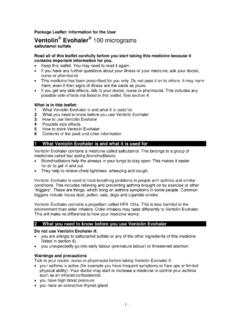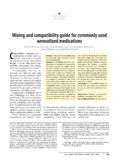Transcription of GSKPro for Healthcare Professionals
1 1 HIGHLIGHTS OF PRESCRIBING INFORMATION These highlights do not include all the information needed to use VE NT OL IN HFA saf ely an d ef f ectively. S ee f u ll p rescrib in g in f ormation f or ventolin HFA. ventolin HFA (alb u terol su lf ate inhalation aerosol), for oral inhalation use Initial Approval: 1981 ------------------------------- INDICATIONS AND USAGE ------------------------------ ventolin HFA is a beta2-adrenergic agonist indicated for: Treatment or prevention of bronchospasm in adult and pediatric patients aged 4 years and older with reversible obstructive airway disease. ( ) Prevention of exercise-induced bronchospasm in adult and pediatric patients aged 4 years and older. ( ) --------------------------DOSAGE AND ADMINISTRATION ------------------------- For oral inhalation only. (2) Treatment or prevention of bronchospasm in adult and pediatric patients aged 4 years and older: 2 inhalations by oral inhalation every 4 to 6 hours.
2 For some patients, 1 inhalation every 4 hours may be sufficient. ( ) Prevention of exercise-induced bronchospasm in adult and pediatric patients aged 4 years and older: 2 inhalations by oral inhalation 15 to 30 minutes before exercise. (2. 2) Priming information: Prime ventolin HFA before using for the first time, when the inhaler has not been used for more than 2 weeks, or when the inhaler has been dropped. To prime ventolin HFA, release 4 sprays into the air away from the face, shaking well before each spray. ( ) Cleaning information: At least once a week, wash the actuator with warm water and let it air-dry completely. ( ) ------------------------ DOSAGE FORMS AND STRENGTHS------------------------ Inhalation aerosol: 108 mcg albuterol sulfate (90 mcg albuterol base) per actuation. (3) ---------------------------------- CONTRAINDICATIONS --------------------------------- Hypersensitivity to any ingredient.
3 (4) -------------------------- WARNINGS AND PRECAUTIONS -------------------------- Life-threatening paradoxical bronchospasm may occur. Discontinue ventolin HFA immediately and institute alternative therapy. ( ) Need for more doses of ventolin HFA than usual may be a sign of deterioration of asthma and requires reevaluation of treatment. ( ) ventolin HFA is not a substitute for corticosteroids. ( ) C ardiovascular effects may occur. Use with caution in patients sensitive to sympathomimetic drugs and patients with cardiovascular or convulsive disorders. ( , ) Excessive use may be fatal. Do not exceed recommended dose. ( ) Immediate hypersensitivity reactions may occur. Discontinue ventolin HFA immediately. ( ) Hypokalemia and changes in blood glucose may occur. ( , ) ---------------------------------- ADVERSE REACTIONS------------------------------- --- Most common adverse reactions (incidence 3%) are throat irritation, viral respiratory infections, upper respiratory inflammation, cough, and musculoskeletal pain.
4 ( ) To report SUSPECTED ADVERSE REACTIONS, contact GlaxoSmithKline at 1-888-825-5249 or FDA at 1-800-FDA-1088 or ---------------------------------- DRUG INTERACTIONS---------------------------- ------ B eta-blockers: Use with caution. May block bronchodilatory effects of beta-agonists and produce severe bronchospasm. ( ) Diuretics: Use with caution. Electrocardiographic changes and/or hypokalemia associated with non potassium-sparing diuretics may worsen with concomitant beta-agonists. ( ) Digoxin: May decrease serum digoxin levels. Consider monitoring digoxin levels. ( ) Monoamine oxidase inhibitors and tricyclic antidepressants: Use with extreme caution. May potentiate effect of albuterol on vascular system. ( ) See 17 f or PATIENT COUNSELING INFORMATION and FDA-approved patient labeling. Revised : 8/2021 _____ FULL PRESCRIBING INFORMATION: CONTENTS* 1 INDICATIONS AND USAGE Bronchospasm Exercise-Induced Bronchospasm 2 DOSAGE AND ADMINISTRATION Recommended Dosage for Bronchospasm (Acute Episodes or Symptoms Associated with Bronchospasm)
5 Recommended Dosage for Prevention of Exercise-Induced Bronchospasm Administration Information 3 DOSAGE FORMS AND STRENGTHS 4 CONTRAINDICATIONS 5 WARNINGS AND PRECAUTIONS Paradoxical Bronchospasm Deterioration of Asthma Use of Anti-inflammatory Agents C ardiovascular Effects Do Not Exceed Recommended Dose Hypersensitivity Reactions, including Anaphylaxis Coexisting Conditions Hypokalemia 6 ADVERSE REACTIONS Clinical Trials Experience Postmarketing Experience 7 DRUG INTERACTIONS B eta-Adrenergic Receptor Blocking Agents Non Potassium-Sparing Diuretics Digoxin Monoamine Oxidase Inhibitors and Tricyclic Antidepressants 8 USE IN SPECIFIC POPULATIONS P regnancy Lactation P ediatric Use Geriatric Use 10 OVERDOSAGE 11 DESCRIPTION 12 CLINICAL PHARMACOLOGY Mechanism of Action P harmacokinetics 13 NONCLINICAL TOXICOLOGY Carcinogenesis, Mutagenesis, Impairment of Fertility Animal Toxicology and/or Pharmacology 14 CLINICAL STUDIES Bronchospasm Associated with Asthma Exercise-Induced Bronchospasm 16 HOW SUPPLIED/STORAGE AND HANDLING 17 PATIENT COUNSELING INFORMATION *Sections or subsections omitted from the full prescribing information are not listed.
6 _____ 2 FULL PRESCRIBING INFORMATION 1 INDICATIONS AND USAGE Bronchospasm ventolin HFA is indicated for the treatment or prevention of bronchospasm in adult and pediatric patients aged 4 years and older with reversible obstructive airway disease. Exercise-Induced Bronchospasm ventolin HFA is indicated f or the prevention of exercise-induced bronchospasm in adult and pediatric patients aged 4 years and older. 2 DOSAGE AND ADMINISTRATION Recommended Dosage for Bronchospasm (Acute Episodes or Symptoms Associated with Bronchospasm) Adult and pediatric patients aged 4 years and older: 2 inhalations by oral inhalation repeated every 4 to 6 hours; in some patients, 1 inhalation every 4 hours may be sufficient. More frequent administration or a greater number of inhalations is not recommended. Recommended Dosage for Prevention of Exercise-Induced Bronchospasm Adult and pediatric patients aged 4 years and older: 2 inhalations by oral inhalation 15 to 30 minutes before exercise.
7 Administration Information ventolin HFA should be administered by the orally inhaled route only. Priming Priming ventolin HFA is essential to ensure appropriate albuterol content in each actuation. Prime ventolin HFA before using for the first time, when the inhaler has not been used for more than 2 weeks, or when the inhaler has been dropped. To prime ventolin HFA, release 4 sprays into the air away from the face, shaking well before each spray. Avoid spraying in eyes. Cleaning To ensure proper dosing and to prevent actuator orifice blockage, wash the actuator with warm water and let it air-dry completely at least once a week. 3 DOSAGE FORMS AND STRENGTHS Inhalation aerosol: 108 mcg of albuterol sulfate (90 mcg of albuterol base) from the mouthpiece per actuation. Blue plastic inhaler with a blue cap containing a pressurized metered-dose aerosol canister containing 60 or 200 metered inhalations and fitted with a counter. 3 4 CONTRAINDICATIONS ventolin HFA is contraindicated in patients with a history of hypersensitivity to any of the ingredients [see Warnings and Precautions ( ), Description (11)].
8 5 WARNINGS AND PRECAUTIONS Paradoxical Bronchospasm ventolin HFA can produce paradoxical bronchospasm, which may be life threatening. If paradoxical bronchospasm occurs f ollowing dosing with ventolin HFA, it should be discontinued immediately and alternative therapy should be instituted. It should be recognized that paradoxical bronchospasm, when associated with inhaled formulations, frequently occurs with the f irst use of a new canister. Deterioration of Asthma Asthma may deteriorate acutely over a period of hours or chronically over several days or longer. If the patient needs more doses of ventolin HFA than usual, this may be a marker of destabilization of asthma and requires reevaluation of the patient and treatment regimen, giving special consideration to the possible need for anti-inflammatory treatment, , corticosteroids. Use of Anti-i nflammatory Agents The use of beta-adrenergic agonist bronchodilators alone may not be adequate to control asthma in many patients.
9 Early consideration should be given to adding anti-inflammatory agents, , corticosteroids, to the therapeutic regimen. Cardiovascular Effects ventolin HFA, like all other beta2-adrenergic agonists, can produce clinically signif icant cardiovascular effects in some patients such as changes in pulse rate or blood pressure. If such effects occur, ventolin HFA may need to be discontinued. In addition, beta-agonists have been reported to produce electrocardiogram (ECG) changes, such as flattening of the T wave, prolongation of the QTc interval, and ST segment depression. The clinical relevance of these f indings is unknown. Therefore, ventolin HFA, like all other sympathomimetic amines, should be used with caution in patients with underlying cardiovascular disorders, especially coronary insufficiency, cardiac arrhythmias, and hypertension. Do Not Exceed Recommended Dose Fatalities have been reported in association with excessive use of inhaled sympathomimetic drugs in patients with asthma.
10 The exact cause of death is unknown, but cardiac arrest following an unexpected development of a severe acute asthmatic crisis and subsequent hypoxia is suspected. Hypersensitivity Reactions, including Anaphylaxis Immediate hypersensitivity reactions ( , urticaria, angioedema, rash, bronchospasm, 4 hypotension), including anaphylaxis, may occur af ter administration of ventolin HFA [see Contraindications (4)]. Coexisting Conditions ventolin HFA, like other sympathomimetic amines, should be used with caution in patients with convulsive disorders, hyperthyroidism, or diabetes mellitus and in patients who are unusually responsive to sympathomimetic amines. Large doses of intravenous albuterol have been reported to aggravate preexisting diabetes mellitus and ketoacidosis. Hypokalemia Beta-adrenergic agonist medicines m a y produce significant hypokalemia in some patients, possibly through intracellular shunting, which has the potential to produce adverse cardiovascular effects [see Clinical Pharmacology ( )].
